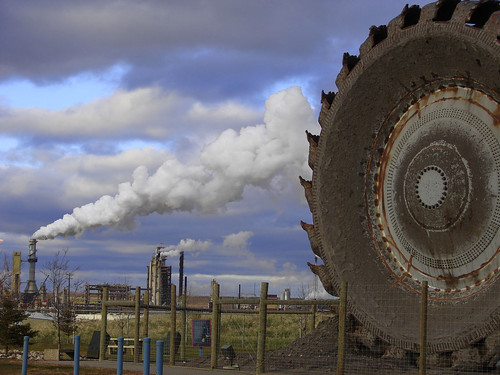
It’s safe to say that the Alberta Oil Sands have achieved a singular level of regard in the national imagination. Images of them proliferate the media. Usually beautifully detailed and taken from great heights, they conjure up anxieties running deep in our culture — of thirst and demolition and bewildered entitlement. They are the largest and perhaps most important industrial energy project in the world. And I wonder, after seeing the provocative and powerful documentary H2Oil, if the Oil Sands aren’t simply an icon for our times, but if they are perhaps some great metonymy for them as well. Cruising across their unreal expanse at the beginning of the film, we acquire the sense that what’s visible of the Sands can only ever stand for something larger. The Oil Sands are a flash-point for volatile inter-provincial debate, a bulging knot in the North American petroleum market, the fuel for our cities, and an environmental wager of global proportions.
The best thing about H2Oil is perhaps also its admirable weakness — it refuses to define the Oil Sands from any singular vantage. There are many important stories to tell about the Oil Sands, and H2Oil tells of a lot of them. It explores the political economy of oil, taking us into an Oil Sands Buyer Convention in Edmonton. It assesses the ecological devastation caused by the Oil Sands projects, showing us interviews with renowned ecologists David Schindler and Kevin Timoney. Through the stunning animation work of James Braithwaite, it visualises the costly and unusual method by which bituminous oil is separated from the deposits contained deep underground. Throughout, the film maintains a sense of the rich interdependancies that exist between these narratives.
Interestingly, the central storyline in H2Oil is perhaps also the hardest one to picture: the story about tiny strains of arsenic and mercury that started traveling through the waters of the Athabasca. About 200km downstream of the Oil Sands, the residents of Fort Chipewyan began witnessing declining fish populations, and weird ailments in their small game. This, it turns out, is nothing new: we learn from candid interviews with local residents that Oil Sands- related contaminants have been impacting their local ecologies for decades. But as the energy projects have picked up in the last 7 years, so too have basic forms of sustenance become more and more dangerous to consume. Forms of cancer than should only happen to one in one hundred thousand people have begun to hit — and kill — the residents of Fort Chipewyan at truly alarming rates.
“I just couldn’t believe these things were happening and the oil companies weren’t taking it seriously†writer/director Shannon Walsh tells me over the phone. One of H2Oil’s main subjects is Athabasca Chipewyan Chief Allan Adam. I ask her about a memorable scene in the film where Adam walks us through Fort Chipewayn, the majestic Athabasca behind him glittering in the low Northern landscape. “Fort Chipewyan is an inspiring community, and a truly beautiful place†she says. “There are strong people there and I feel honoured that they would share their stories with me. They can be just so painful.†Walsh is uncompromisingly critical of the big oil companies who remain skeptical of claims to their culpability. Alberta Energy Minister Mel Knight also disagrees, telling us that the Oil Sands are closely monitored for health impacts, that their large pools of contaminated sludge are well contained within mud parapets. But for Walsh, responsibility for the Oil Sands extends beyond Shell and Syncrude, and even Alberta; it encompasses the entire country. “The Oil Sands weren’t a major issue in the 2006 Federal Election,†she explains, “And they should have been. They have been hidden away from most of the country for a long time. But I think at last that’s changing.â€
The world Premiere of H2Oil happens tonight (May 8th) and Bloor Cinema, 506 Bloors St. West, 6:30pm. and also on Sunday at the ROM theatre at 11:30AM.
On Saturday May 9th (252 Bloor St West, Room #2-211 in OISE, 1:00pm), The Indigenous Environmental Network, the Polaris Institute and Loaded Pictures will organize an action event in conjuction with the screening of H2Oil. Participants include George Poitras of the Mikisew Cree First Nation, Chief Allan Adam of the Athabascan Chipewyan First Nation, Clayton Thomas-Mueller from the Indigenous Environmental Network, Eriel Tchekwie-Deranger from Rainforest Action Network and Tony Clarke, author of Tar Sands Showdown.


